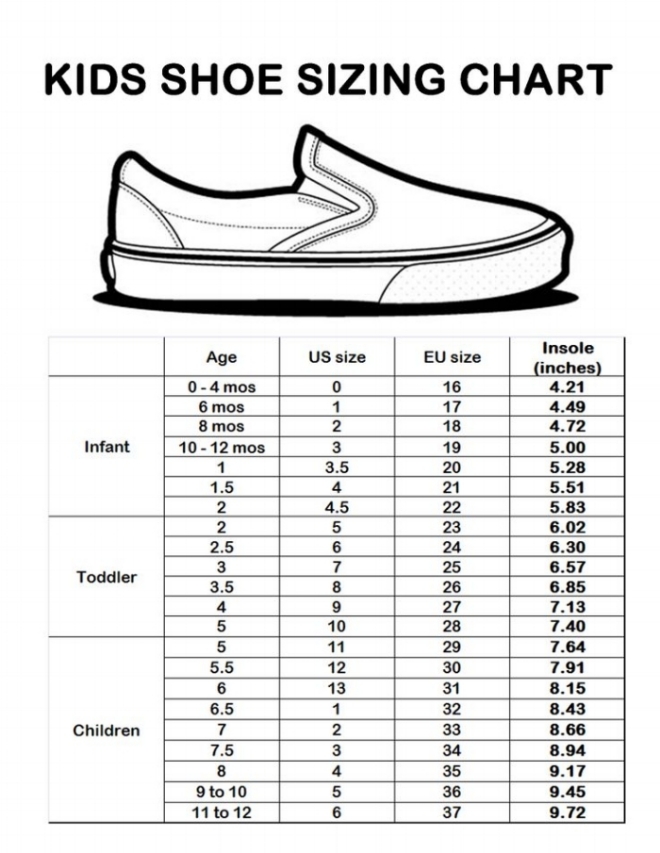The Ultimate Children’s Shoe Size Guide for Parents
Hello, lovely parents! Is it time to upgrade your little one’s shoes again? They grow up so fast, don’t they? Well, don’t worry! We’ve created the ultimate children’s shoe size guide that will make finding the perfect fit as fun and easy as a walk in the park! Let’s get those tiny toes ready for the journey ahead!
Understanding the Basics of Kids’ Shoe Sizing
The right shoe size is crucial for your child’s comfort and foot development. Shoes that are too tight can cause blisters and other foot problems, while shoes that are too large can lead to tripping and poor walking patterns. So let’s start by understanding the basics, shall we?
How Shoe Sizes Work
- Length: Children’s shoe sizes are largely determined by the length of the foot, which is measured from the heel to the tip of the longest toe.
- Width: Some brands also offer width options because kiddos’ feet vary not just in length, but in width as well. You might find narrow, medium, and wide options available.
- Age Guides: Age can be a starting point, but remember, kids grow at their own unique pace, and foot size doesn’t strictly correlate with age.
Measuring Your Child’s Foot
For the most accurate measurement, we recommend visiting a professional. But for those of you who are DIY-ers, here’s a simple way to measure at home:
- Place a piece of paper on a hard floor against a wall.
- Have your child stand on the paper with one foot pressing flat against the wall, their heel touching the wall, and their longest toe pointing straight ahead.
- Mark the paper at the tip of the longest toe and then measure the distance from the end of the paper to the mark.
- Repeat with the other foot and use the larger measurement as a reference.
Always remember that feet can be different sizes, and it’s normal! Choose the shoe size that fits the larger foot comfortably.
Finding the Right Fit
Finding the right shoe size is not just about the length of the foot. The shoe also needs to fit well and provide proper support for your child’s entire foot.
- Tip: Look for a thumb’s width of space between the tip of the shoe and the tip of your child’s toe—this allows for growth and movement.
- Heel Fit: The heel should fit snugly against the back of the shoe without slipping out as your child walks.
- Depth and Width: Ensure there’s enough room for the toes to wriggle but not too much to cause the foot to slide around in the shoe.
Remember, not all brands size the same, so it’s always best to check their specific size chart or, better yet, try the shoes on in-person whenever possible.
Size Charts and Conversion
To help you navigate through different brands and countries’ sizing methods, here’s a quick size chart to reference:
Baby/Toddler Shoe Size Conversion (0-4 years)
| US | UK | EU | Foot length (inches) | Foot length (cm) |
|---|---|---|---|---|
| 4C | 3.5 | 19 | 4.5″ | 11.4 |
Note: The above chart is a simplified sample. Brands can vary in their sizing, so always refer to the brand-specific size guides where possible.
Finding the perfect pair of shoes for your child doesn’t have to be a hassle. With patience and the proper guide at your fingertips, you will easily step your way through the vast array of sizes and styles. Remember to check their fit regularly, and above all, have fun choosing those cute little shoes!
Stay tuned as we continue to delve deeper into the world of children’s footwear, offer expert fitting advice, and provide answers to frequently asked questions. So go ahead, let your child lead the footrace, and let’s make those shoe-shopping trips a breeze together!

5 Things Parents Should Know in Preparing for Children’s Shoe Size Guide
Ready to go shoe shopping? Here are five essential tips to keep in mind:
- Keep Up with Growth: Children’s feet grow quickly! Did you know that kids’ feet can grow up to half a size every three to four months? This means regular check-ins are a must. Try to measure your little one’s feet every two months for toddlers and every three to four months for older children.
- Understanding Shoe Size Tiers: There are three tiers to consider: crib shoes (sizes 0-3 for newborns to about 9 months), toddler shoes (sizes 4-10 for approximately 9 months to 4 years), and kids’ shoes (sizes 10.5 and up, usually for kids 4 to 8 years old).
- The Socks Matter: Always bring the type of socks your child will wear with the new shoes to ensure the fit is perfect. This can prevent choosing a size that’s too snug once those thicker winter socks are on, or too loose with thinner summer socks.
- Arch Support and Sole Flexibility: Look for a shoe that provides good arch support for your child but also offers flexibility. A stiff sole can hinder proper foot development. Test this by bending the shoe – it should bend at the ball and not much elsewhere.
- Materials Make a Difference: Choose breathable materials like leather or canvas that allow the child’s foot to keep cool and reduce the risk of discomfort and odors. Also, opting for shoes with a durable material can save you money in the long run as they’re more likely to withstand the playground test!
Subtle Signs It’s Time for a New Pair
Be on the lookout for these not-so-obvious signs that your child may need new shoes:
- An increase in stumbling or tripping may indicate that shoes have become too small.
- Look for any pronounced wear and tear in the toe area or sides; it’s a sign that the shoe may be too tight or too wide.
- Pay attention to your child’s behavior. If they’re more reluctant to walk or play or they’re removing their shoes frequently, the shoes might be uncomfortable.
- Check for red marks on the feet when you remove the shoes, as these can indicate pressure points from a bad fit.
- And finally, listen to your child: if they complain about their shoes or you notice they always want to wear a different pair, it’s probably time for a change!
Why Fitting In-Store Can Be Beneficial
Whenever possible, take your child shoe shopping at a physical store. Here’s why it’s a game-changer:
- Instantly try on multiple sizes and styles to find the best fit.
- Get professional help from store associates who are trained in children’s footwear fitting.
- Watch your child walk in the shoes to catch any fitting issues like slipping or gapping right away.
- Engage your child in the selection process, making them feel involved and excited about their new shoes.
Remember, the shoe fitting experience should be positive for your little one, as it sets the foundation for their comfort in walking, running, and playing!
Online Shopping Tips for Children’s Shoes
If you’re considering online shopping, here’s how to keep the process as seamless as possible:
- Always check the retailer’s return policy; free returns can make all the difference.
- Review customer feedback for insights on sizing – other parents’ experiences can guide you correctly.
- Look for online fitting tools and printable size charts that brands may offer on their sites.
- Consider ordering multiple sizes and returning what doesn’t fit to ensure you find the perfect match.
Keeping these tips in mind will ensure you’re well-equipped to navigate the world of children’s shoe sizes with confidence. Enjoy the journey of picking out delightful footwear for your little one, for the right pair of shoes will support not just their feet, but also their adventures!
For more great articles please see here. For more information see here
Disclaimer
The articles available via our website provide general information only and we strongly urge readers to exercise caution and conduct their own thorough research and fact-checking. The information presented should not be taken as absolute truth, and, to the maximum extent permitted by law, we will not be held liable for any inaccuracies or errors in the content. It is essential for individuals to independently verify and validate the information before making any decisions or taking any actions based on the articles.




